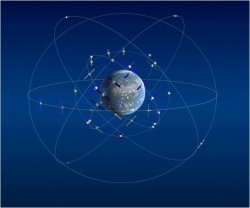If you wish to contribute or participate in the discussions about articles you are invited to contact the Editor
BeiDou Space Segment
| COMPASS | |
|---|---|
| Title | BeiDou Space Segment |
| Author(s) | GMV. |
| Level | Basic |
| Year of Publication | 2011 |
The Compass Navigation Satellite System (CNSS), or BeiDou-2, is China’s second-generation satellite navigation system capable of providing positioning, navigation, and timing services to users on a continuous worldwide basis.
The system has evolved from a regional system called BeiDou-1, and in the first phase will provide high-accuracy positioning services for users in China and its neighbouring regions. The long-term goal is to develop an independent global navigation satellite network similar to the GPS and GLONASS. [1]
COMPASS Space Segment
The COMPASS Space Segment will consist of a constellation of 35 satellites, which include 5 geostationary orbit (GEO) satellites and 30 non-GSO satellites; 27 in Medium Earth Orbit (MEO) and 3 in Inclined GSO (IGSO),that will offer complete coverage of the globe.[2]
It is planned that Compass system will have more than 10 satellites by 2012 and may offer services for the Asia-Pacific region. The global navigation system should be finished by 2020.[3]
As of April 2011, eight satellites for Compass have been launched. According to an official report [4], " the eighth Beidou satellite marks the completion of basic function of Beidou (Compass) Navigation Satellite System and will collaborate with five navigation satellites launched last year to establish a navigating system of three GEO (geostationary orbit) satellites plus three IGSO (Inclined Geo Synchronous orbit) satellites. The system will be able to provide services to most regions in China after a period of orbiting running tests and system integration. "
| Date | Launcher | Satellite | Orbit | Usable | System |
|---|---|---|---|---|---|
| 4/14/2007 | Long March 3A (LM-3A) | Compass-M1 | MEO ~21,500 km | Testing only | Compass |
| 4/15/2009 | Long March 3C (LM-3C) | Compass-G2 | GEO Drifting | No | |
| 1/17/2010 | LM-3C | Compass-G1 | GEO 144.5°E | Yes | |
| 6/2/2010 | LM-3C | Compass-G3 | GEO 84°E | Yes | |
| 8/1/2010 | LM-3A | Compass-IGSO1 | IGSO 118°E incl 55° | Yes | |
| 11/1/2010 | LM-3C | Compass-G4 | GEO 160°E | Yes | |
| 12/18/2010 | LM-3A | Compass-IGSO2 | IGSO 118°E incl 55° | Yes | |
| 04/10/2011 | LM-3A | Compass-IGSO3 | IGSO 118°E incl 55°, 200~35,991km | Yes |
The nominal constellation includes 35 satellites, 5 GEOs, 3 IGSOs and 27 MEOs. The number of IGSO orbits is 3, and 1 IGSO per plane. The intersection node is 118E. While the MEO constellation is Walker constellation; 24 MEOs in 3 planes plus 3 spares. The orbital parameters of the final constellation are shown in the following table:[5]
| Orbit parmts. | GEO | IGSO | MEO |
|---|---|---|---|
| Semi-Major Axis (Km) | 42164 | 42164 | 27878 |
| Eccentricity | 0 | 0 | 0 |
| Inclination (deg) | 0 | 55 | 55 |
| RAAN (deg) | 158.75E, 180E, 210.5E, 240E,260E | 218E,98E,338E | -- |
| Argument Perigee | 0 | 0 | |
| Mean anomaly (deg) | 0 | 218E:0,98E:120,338E:240 | |
| # Sats | 5 | 3 | 27 |
| # Planes | 1 | 3 | 3 |
Notes
References
- ^ Compass on the Chinese Defence Today website
- ^ BeiDou and Compass in Wikipedia
- ^ a b BeiDou navigation system covers Asia-Pacific region till 2012, 2010-03-03 by Xinhua News Agency
- ^ China completes basic Beidou (Compass) Navigation Satellite System, 2011-04-10 by Globaltimes.cn
- ^ COMPASS Status Presentation, Munich Satellite Navigation Summit March 2011.

